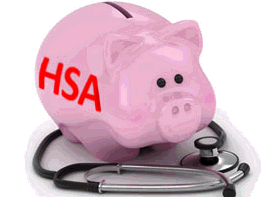Health Savings Accounts (HSAs) – An Overview
Aug 2, 2017 • Written by Paul Staib | Certified Financial Planner (CFP®), MBA, RICP®
Blog Home » Financial Planning » Health Savings Accounts (HSAs) – An Overview

Description
Health Savings Accounts (HSA) were created by the Medicare bill signed by President Bush on December 8, 2003 and are designed to help individuals save for future qualified medical and retiree health expenses on a tax-free basis.
Health Savings Accounts are tax-deductible savings plans that allow a taxpayer to save pre-tax dollars for future healthcare expenses. HSA are paired with high-deductible health insurance plans.
- Contributions to an HSA are tax-deductible.
- Earnings, such as interest and dividends, in the health savings account are tax-exempt.
- Withdrawals from a health savings account are tax-free as long as the funds are used for qualified medical expenses.
About HSAs
Any adult who is covered by a high-deductible health plan (and has no other first-dollar coverage) may establish an HSA. Tax-advantaged contributions can be made in three ways:
- the individual or family can make tax deductible contributions to the HSA even if they do not itemize deductions;
- the individual’s employer can make contributions that are not taxed to either the employer or the employee; and,
- employers sponsoring cafeteria plans can allow employees to contribute untaxed salary through salary reduction.
Amounts contributed to an HSA belong to the account holder and are completely portable. Funds in the account can grow tax-free through investment earnings, just like an Individual Retirement Account (IRA).
Funds distributed from the HSA are not taxed if they are used to pay qualified medical expenses. Unlike amounts in Flexible Spending Arrangements that are forfeited if not used by the end of the year, unused funds remain available for use in later years.
HSA allow consumers to pay for qualified medical expenses with pre-tax dollars—meaning income-tax free—and save for retirement on a tax-deferred basis. An HSA is tax-favored savings account that is used in conjunction with a high-deductible HSA-eligible health insurance plan to make healthcare more affordable and to save for retirement.
HSAs are similar to individual retirement accounts (IRAs), but even better in that:
- Pre-tax money is deposited each year into an HSA and can be easily withdrawn at any time with no penalty or taxes to pay for qualified medical expenses. Withdrawals can also be made for non-medical purposes, but will be taxed as normal income and are subject to a 10 percent penalty if done prior to age 65.
- Any HSA funds not used each year remain in the account, and earn interest and/or gains tax-free to supplement medical expenses at any time in the future.
- Like an IRA, the account belongs to you, not your employer. But unlike an IRA, your employer CAN contribute to your HSA.
Why should I consider an HSA?
You may save money in the short and long term by:
- Deducting 100% of your HSA contributions from your taxable income
- Having the money in your HSA accrue interest and/or gains on a tax-free basis
- Paying no penalties or taxes when you use your HSA to pay for qualified medical expenses
- Having a high-deductible HSA-eligible health insurance plan, which typically has a lower premium than a plan with a lower deductible
Note: Some HSAs charge a small monthly maintenance fee.
High-Deductible Health Plan (HDHP)
A high-deductible health plan (HDHP) is a health insurance plan with lower premiums and higher deductibles than a traditional health plan. Participating in a “qualified” HDHP is a requirement for HSA and other tax-advantaged programs. HDHPs are plans with a minimum deductibles and maximum out of pocket limits as specified by the Internal Revenue Service. The IRS adjusts these figures annually to reflect the change in cost of living.
Contribution Limits
Maximum yearly contributions to HSAs (and associated tax deduction) are specified by the IRS. For 2021, the maximum contribution for a single person is $3,600, the maximum for a family is $7,200. To encourage saving for health expenses after retirement, individuals age 55 and older are allowed to make additional catch-up contributions to their HSAs in the amount of $1,000. Once an individual enrolls in Medicare they are no longer eligible to contribute to their HSA.
Investments
Funds in an HSA can be invested in a manner similar to investments in an Individual Retirement Account (IRA). Investment earnings are sheltered from taxation until the money is withdrawn.
While HSAs can be “rolled over” from fund to fund, an HSA cannot be rolled into an IRA or a 401(k), and funds from these types of investment vehicles cannot be rolled into an HSA. Unlike some employer contributions to a 401(k) plan, all HSA contributions belong to the participant immediately (there is no vesting), regardless of the deposit source. A person contributing to an HSA is under no obligation to contribute to his or her employer-sponsored HSA, although employers may require that payroll contributions be made only to the sponsored HSA plan.
Withdrawals – How Do I Use HSA Funds
Using funds in your Health Savings Account is easy:
- There are several ways that funds in an HSA can be withdrawn. Some HSAs include a debit card, some supply checks for account holder use, and some allow for a reimbursement process similar to medical insurance. Most HSAs have more than one possible method for withdrawal.
- You do not need to obtain advance approval from the HSA administrator when you use funds in your account and the funds are not subject to income taxation if made for qualified medical expenses.
- HSA funds can be withdrawn for any reason, but withdrawals that are not for documented qualified medical expenses are subject to income taxes and a 10% penalty.
- The 10% tax penalty is waived for persons who have reached the age of 65 or have become disabled at the time of the withdrawal.
- Then, only income tax is paid on the withdrawal, and in effect the account has grown tax deferred (similar to an IRA)
- Withdrawals for qualified medical expenses continue to be tax free.
- You do not need to submit receipts to the HSA administrator, although you should save them just as you keep receipts for other items that are deducted from your taxes.
- The 10% tax penalty is waived for persons who have reached the age of 65 or have become disabled at the time of the withdrawal.
NOTE: You must establish the HSA before you incur medical expenses otherwise the expenses will not qualify.
Qualified Medical Expenses
HSAs can be used to pay for many types of medical expenses, even some that are often excluded on health insurance plans. These include:
- Health insurance plan deductibles, copayments, and coinsurance
- Prescription and over-the-counter drugs
- Dental services, including braces, bridges, and crowns
- Vision care, including glasses and lasik eye surgery
- Psychiatric and certain psychological treatments
- Long-term care services
- Medically-related transportation and lodging
Typically HSAs cannot be used to pay health insurance premiums, although there are exceptions for:
- Health insurance premiums if you are receiving federal or state unemployment benefits
- Premiums for COBRA qualified health insurance
- Certain qualified long-term care insurance premiums
- Premiums for a health plan (other than a Medicare supplemental policy) for an individual age 65 or older
Note: You must establish an HSA before incurring any expenses or the expenses will not qualify
Note: Refer to IRS Publication 502, Medical and Dental Expenses for what counts as qualified medical expenses.
How Do the Tax Savings Work
HSAs make it easy to save on your taxes:
- At the end of each year, you will be sent a statement showing the amount you contributed to your HSA that year. You can deduct this amount provided it is less than or equal to the maximum allowable contribution.
- Much like an IRA, HSA deductions are “above-the-line” and thus can be taken even if you do not itemize.
- If you are self-employed, in addition to deducting your HSA contributions, you may be able to deduct 100% of your health insurance premiums, provided that:
- You are not eligible to participate in a subsidized health plan offered by an employer or your spouse’s employer.
- The deduction does NOT exceed the amount of net income from your business.
Note: Check with your accountant or tax advisor for the specific federal and state tax benefits that apply to you

Paul Staib | Certified Financial Planner (CFP®), MBA, RICP®
Paul Staib, Certified Financial Planner (CFP®), RICP®, is an independent Flat Fee-Only financial planner. Staib Financial Planning, LLC provides comprehensive financial planning, retirement planning, and investment management services to help clients in all financial situations achieve their personal financial goals. Staib Financial Planning, LLC serves clients as a fiduciary and never earns a commission of any kind. Our offices are located in the south Denver metro area, enabling us to conveniently serve clients in Highlands Ranch, Littleton, Lone Tree, Aurora, Parker, Denver Tech Center, Centennial, Castle Pines and surrounding communities. We also offer our services virtually.
Read Next
Retirement Planning: Healthcare Risk
• Written By Paul Staib | Certified Financial Planner (CFP®), MBA, RICP®
Healthcare will be one of the largest categories of expense for most retirees – and medical inflation is expected to…
Are You on Track for Retirement?
• Written By Paul Staib | Certified Financial Planner (CFP®), MBA, RICP®
As a financial planner, I receive questions on a daily basis regarding individual’s finances. While every question is different, ultimately…
